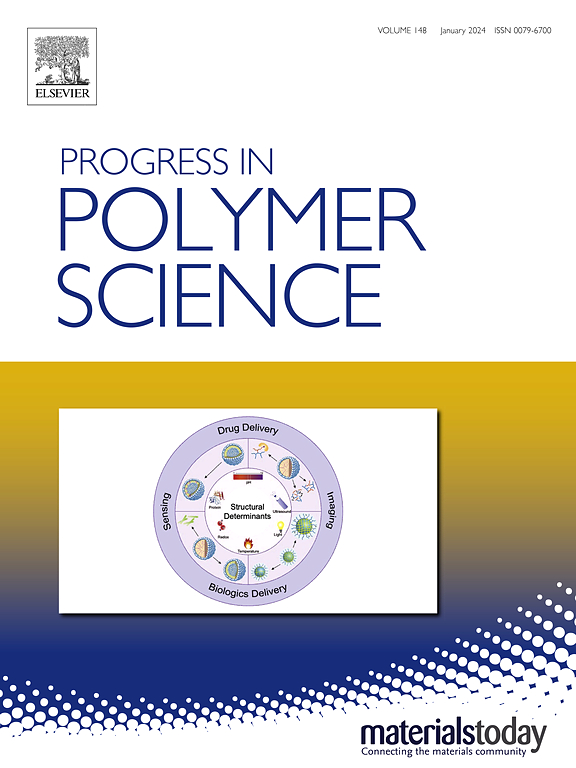Emulsion templating: DIY versatility for the creative design of macroporous polymers
IF 26.1
1区 化学
Q1 POLYMER SCIENCE
引用次数: 0
Abstract
Porous polymers are of interest for a wide variety of applications including absorption, adsorption, tissue engineering, membranes, controlled release, reaction supports, and shape memory foams. Emulsion templating can be used to generate high-porosity, macroporous polymer monoliths with highly interconnected, micrometer-scale porous structures through polymerization in the external, continuous phase followed by removal of the internal, dispersed phase. Emulsion templating possesses, on one hand, the benefit of being seemly simple. This simplicity, however, belies its inherent versatility and considerable parameter space that enables creative design of innovative new materials in terms of their macromolecular structures, their porous structures, and their properties. As described here, approaching emulsion templating with a specific structure or application in mind can enable a do-it-yourself outlook to imaginatively selecting the most appropriate emulsion type, stabilization strategy, polymerization mechanism, crosslinking strategy, and post-synthesis modification. The research and development of emulsion-templated polymers has been blossoming, as reflected not only in the number of articles published, but also in the number of novel porous polymer materials synthesized and in the number of heretofore unexplored applications investigated. It is the hidden complexity of emulsion templating that enables a continuous stream of pioneering works stemming from breakthrough insights in connected and contiguous scientific fields. This appraisal, highlighting emulsion templating strategies, will serve as a guide for those involved in developing innovative polymers with unique macromolecular and porous structures that engender exceptional properties. Contemplating the future directions of emulsion templating, given the robust nature of its established foundation, suggests that innovative research and development will continue to flourish.


乳液模板:DIY多功能性,用于大孔聚合物的创意设计
多孔聚合物具有广泛的应用前景,包括吸收、吸附、组织工程、膜、控制释放、反应支撑和形状记忆泡沫。通过外部连续相的聚合,然后去除内部分散相,乳液模板可以生成具有高度互连、微米级多孔结构的高孔隙率、大孔聚合物单体。乳液模板具有,一方面,看似简单的好处。然而,这种简单性掩盖了其固有的多功能性和可观的参数空间,使创新的新材料在其大分子结构、多孔结构和性能方面的创造性设计成为可能。正如本文所描述的,以特定的结构或应用来处理乳液模板可以使自己动手的观点能够富有想象力地选择最合适的乳液类型,稳定策略,聚合机制,交联策略和合成后改性。乳液模板聚合物的研究和开发一直在蓬勃发展,这不仅反映在发表的文章数量上,也反映在合成的新型多孔聚合物材料的数量和迄今为止未开发的应用研究的数量上。正是乳液模板的隐藏复杂性,使得在相互关联和连续的科学领域中产生突破性见解的开创性作品源源不断。这一评价强调了乳液模板策略,将为那些参与开发具有独特大分子和多孔结构的创新聚合物的人提供指导,这些聚合物可以产生特殊的性能。考虑到乳液模板的未来发展方向,鉴于其坚实的基础,创新的研究和开发将继续蓬勃发展。
本文章由计算机程序翻译,如有差异,请以英文原文为准。
求助全文
约1分钟内获得全文
求助全文
来源期刊

Progress in Polymer Science
化学-高分子科学
CiteScore
48.70
自引率
1.10%
发文量
54
审稿时长
38 days
期刊介绍:
Progress in Polymer Science is a journal that publishes state-of-the-art overview articles in the field of polymer science and engineering. These articles are written by internationally recognized authorities in the discipline, making it a valuable resource for staying up-to-date with the latest developments in this rapidly growing field.
The journal serves as a link between original articles, innovations published in patents, and the most current knowledge of technology. It covers a wide range of topics within the traditional fields of polymer science, including chemistry, physics, and engineering involving polymers. Additionally, it explores interdisciplinary developing fields such as functional and specialty polymers, biomaterials, polymers in drug delivery, polymers in electronic applications, composites, conducting polymers, liquid crystalline materials, and the interphases between polymers and ceramics. The journal also highlights new fabrication techniques that are making significant contributions to the field.
The subject areas covered by Progress in Polymer Science include biomaterials, materials chemistry, organic chemistry, polymers and plastics, surfaces, coatings and films, and nanotechnology. The journal is indexed and abstracted in various databases, including Materials Science Citation Index, Chemical Abstracts, Engineering Index, Current Contents, FIZ Karlsruhe, Scopus, and INSPEC.
 求助内容:
求助内容: 应助结果提醒方式:
应助结果提醒方式:


